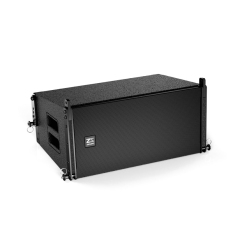Discovering more about how a line array system works is a case of looking into what goes on under-the-hood. A line array system is simply a series of coplanar loudspeakers, where each element produces sound in a slightly different frequency range. This setup in turn allows the speakers to create a consistent and cohesive sound space heard throughout larger rooms The idea behind a line array is wave interference; if the sound waves from one loudspeaker arrive in phase with those of an adjacent speaker, they add together to simultaneously increase both SPL and frequency response on axis.
The line array system can project sound great distances & maintains much greater clarity than conventional speaker systems. A line array system offers extremely narrow vertical coverage angles as low as 10 degrees for exacting control of sound in the vertical domain. This surveillance minimizes the noise from reflections of sound emanating up to and down refracting., resulting in a reduced long-unfinished reverberation reecho.
Power Handling:The power that line array can handle is also very important. For this there are speaker modules in an array to handle generally 500-1000 watts each, providing enough output power for big rooms of audience. Together, their use across the entire array means it can achieve a loud sound pressure level (SPL), often more than 100 dB at one metre from 100m away which makes them perfect for concerts and open-air events. This capability helps to provide everyone in the audience with the same quality of sound, no matter where you are seated relative to stage.
By being able to manipulate the curvature and angle of line arrays. The benefit of this is to achieve the best sound coverage based on the sound environment and acoustics characteristics for each venue. Modeling software can help sound engineers model different arrangements and predict the array's performance to ease setup, with Tx-Rx output levels tune. This level of advance planning results in the sound reaching every listener wherever they are without "holes" or low spots.

Line array systems have been alive in the field due to their wide compatibility and high-performance precision. During the 2008 Beijing Olympics, an advanced line array configuration was used at the opening ceremony to properly convey sound with clarity and precision for each of August Birdsong's notes throughout all 90,000 seats within stadium. This high-profile event really tested the system and its ability to achieve a full-bodied, well-rounded sound under difficult circumstances.
The Beginning of Line Array System Technology in the Market_Line array systems have come a long way since they were first used for even sounding public address, from then to now this technology has become an essential part of multi-purpose audio solutions. Using software to control the array also allows engineers to tweak the system in real time, adjusting which frequencies go where and how loudly. Since the DSP allows modifications to be made in real-time and their corrections are done on-the-fly at live concerts.
Using line array systems in concerts has simply become a norm because of the way they beat concurrent speaker setups conceptually. It not only produces better sound quality but tends to be cheaper in a logistical and setup sense by reducing the number of individual speakers that have to transported, installed, powered up etc. They are a popular choice for touring artists and event organizers who want reliable, no-nonsense audio solutions.
Famed for his creation of the V-DOSC line array system and audio engineer genius, Christian Heil proclaimed, "The power in live sound is when we learn how to master waves." From the beginning his focus has been keenly focused on why innovation was necessary to deliver great audio experiences. For the professional line array column, Heil has set a standard that we rely upon for other design priorities.
When you pull back the curtain and expose a line array system to this kind of objective listening, you start seeing just how well acoustics and engineering have combined. This not only brings the auditory experience of audiences to a new level, it also sets benchmarks in sound production for live events. Those who want to know and learn more can check out line array system for additional information.
